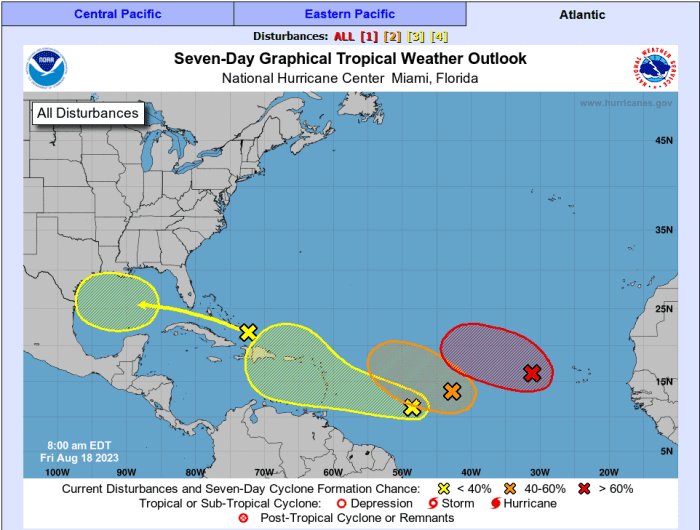As a rare Pacific storm bears down on Mexico and the U.S. Southwest, investors are reminded that the energy market may still see significant disruptions with hurricane season in the Atlantic having just entered its peak.
Several developing weather systems having the potential to disrupt oil and natural-gas production, as well as refining activity, in the Gulf of Mexico.
“There are growing concerns that the weather in the Atlantic could get ugly very quickly,” said Phil Flynn, senior market analyst at The Price Futures Group, in a Friday report. “We have had a relatively quiet hurricane season so far, but now we’re getting into the high point of the season and the tropical storm map from the National Hurricane Center is again looking like somebody spilled some coffee on it.”

U.S. National Hurricane Center’s 7-day graphical tropical weather outlook as of Friday, Aug. 18 at 8 a.m. Eastern time.
U.S. National Hurricane Center
““…the tropical storm map from the National Hurricane Center is again looking like somebody spilled some coffee on it.” ”
Atlantic hurricane season runs from June 1 to Nov. 30, with most activity happening between mid-August and mid-October — and Sept. 10 marking the peak of the season, according to the U.S. National Oceanic and Atmospheric Administration.
As of Friday, there are at least four tropical waves to keep an eye on — with at least two of them with a pretty good chance to get into the Gulf of Mexico and disrupt oil-and-gas operations, said Flynn.
So far this year, oil and natural-gas prices haven’t see much impact from the risks to operations in the Gulf.
As of Friday, U.S. benchmark West Texas Intermediate crude CL.1, +0.18% CLU23, +0.18%, based on the front-month contract, traded around 0.7% lower month to date and has climbed by 1.2% for the year, according to Dow Jones Market Data. U.S. natural-gas futures NG00, +0.86% NGU23, +0.86% have lost nearly 3.2% this month and dropped by 43% year to date.
Meanwhile, Hurricane Hilary was in the headlines on Friday as it reached Category 4 strength off Mexico’s Pacific coast and threatened to return to tropical storm status as it nears Southern California this weekend.
Read: Hurricane Hilary expected to drench California as a tropical storm, first in 84 years
The storm is expected to make landfall on the U.S. West Coast this weekend, but its impact on refining in Southern California will likely be “mostly from flash flooding rather than wind,” Debnil Chowdhury, head of Americas fueling and refining, at S&P Global Commodity Insights, wrote in emailed commentary Friday.
Richard Joswick, head of global oil at S&P Global Commodity Insights said more than 1 million barrels per day of refinery capacity is potentially at risk in Los Angeles/Bakersfield area.
Hilary, however, is a rare weather phenomenon on the Pacific coast. A tropical storm hasn’t made landfall in Southern California since 1939.
For the Atlantic region, NOAA on Aug. 11 updated its 2023 hurricane season outlook report, raising its prediction to an “above normal” level of activity from a “near normal” level. It now sees a 70% chance of 13-21 named storms, with six to 11 of them potentially becoming hurricanes and two to five of those potentially becoming major hurricanes.
The 2023 Atlantic hurricane season started early this year, with the National Hurricane Center on Jan. 16 issuing a tropical weather outlook for a low-pressure system north of Bermuda. “Don” briefly became the first hurricane of the season on July 22.
Monitoring Atlantic hurricanes are important to the oil and natural-gas market given that the Gulf of Mexico federal offshore oil production accounts for 15% of total U.S. crude-oil output, while federal offshore natural-gas production in the Gulf accounts for 5% of the nation’s total dry production, according to the U.S. Energy Information Administration. More than 47% of U.S. petroleum refining capacity and 51% of total U.S. natural-gas processing plant capacity are located along the Gulf coast.
“Whereas onshore wells in East Texas and Louisiana are designed to withstand hurricanes, the same cannot be said of offshore Gulf of Mexico operations, which must be suspended at the drop of a hat,” Manish Raj, managing director at Velandera Energy Partners, told MarketWatch.
“More problematic are infrastructure facilities such as pipelines, processing plants and terminals [which] are more likely to sustain damages due to their larger footprint,” he said.
“Damage to infrastructure is really bad news because such repairs take weeks if not months,” said Raj. “To add insult to injury, infrastructure damage affects the entire production in that area that must all be suspended.”
With oil in the U.S. Strategic Petroleum Reserve at a multidecade low, the U.S. has “limited capacity to absorb a multiweek curtailment,” Raj said.
““ Ignorance is bliss in the oil business, until a hurricane actually comes to town.” ”
For now, however, the energy market is “happy to look the other way and give hurricanes the cold shoulder, since the likelihood of a catastrophic hurricane remains slim, and the market is having too much of a good time,” he said.
“Ignorance is bliss in the oil business, until a hurricane actually comes to town,” said Raj.
